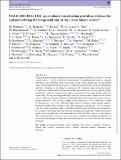OGLE-2014-BLG-1186 : gravitational microlensing providing evidence for a planet orbiting the foreground star or for a close binary source?
Abstract
Discussing the particularly long gravitational microlensing event OGLE-2014-BLG-1186 with a time-scale tE ∼ 300 d, we present a methodology for identifying the nature of localised deviations from single-lens point-source light curves, which ensures that (1) the claimed signal is substantially above the noise floor, (2) the inferred properties are robustly determined and their estimation is not subject to confusion with systematic noise in the photometry, (3) alternative viable solutions within the model framework are not missed. Annual parallax and binarity could be separated and robustly measured from the wing and the peak data, respectively. We find matching model light curves that involve either a binary lens or a binary source, and discover hitherto unknown model ambiguities. Our binary-lens models indicate a planet of mass M2 = (45 ± 9) M⊕, orbiting a star of mass M1 = (0.35 ± 0.06) M⊙, located at a distance DL = (1.7 ± 0.3) kpc from Earth, whereas our binary-source models suggest a brown-dwarf lens of M = (0.046 ± 0.007) M⊙, located at a distance DL = (5.7 ± 0.9) kpc, with the source potentially being a (partially) eclipsing binary involving stars predicted to be of similar colour given the ratios between the luminosities and radii. Further observations might resolve the ambiguity in the interpretation in favour of either a lens or a source binary. We experienced that close binary source stars pose a challenge for claiming the detection of planets by microlensing in events where the source passes very close to the lens star hosting the planet.
Citation
Dominik , M , Bachelet , E , Bozza , V , Street , R A , Han , C , Hundertmark , M , Udalski , A , Bramich , D M , Alsubai , K A , Calchi Novati , S , Ciceri , S , D'Ago , G , Jaimes , R F , Haugbølle , T , Hinse , T C , Horne , K , Jørgensen , U G , Juncher , D , Kains , N , Korhonen , H , Mancini , L , Menzies , J , Popovas , A , Rabus , M , Rahvar , S , Scarpetta , G , Schmidt , R , Skottfelt , J , Snodgrass , C , Southworth , J , Starkey , D , Steele , I A , Surdej , J , Tsapras , Y , Wambsganss , J , Wertz , O , Pietrukowicz , P , Szymański , M K , Mróz , P , Skowron , J , Soszyński , I , Ulaczyk , K , Poleski , R , Wyrzykowski , Ł & Kozłowski , S 2019 , ' OGLE-2014-BLG-1186 : gravitational microlensing providing evidence for a planet orbiting the foreground star or for a close binary source? ' , Monthly Notices of the Royal Astronomical Society , vol. 484 , no. 4 , pp. 5608-5632 . https://doi.org/10.1093/mnras/stz306
Publication
Monthly Notices of the Royal Astronomical Society
Status
Peer reviewed
ISSN
0035-8711Type
Journal article
Description
Funding: UK STFC grant ST/R000824/1 (KH).Collections
Items in the St Andrews Research Repository are protected by copyright, with all rights reserved, unless otherwise indicated.

